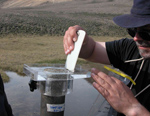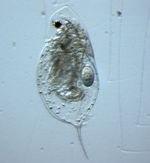An acid rain legacy for Canada’s freshwater lakes

A boreal lake in the Turkey Lakes Watershed, north of Sault Ste. Marie, Ontario. Photo: Dean Jeffries © Environment Canada.
Calcium deficiency is commonly considered an ailment of the elderly – however, many of Canada’s freshwater lakes are now being diagnosed with a similar condition.
Calcium levels in many of Canada’s freshwater lakes are dropping. And just as it’s necessary for a healthy human body, calcium is also essential for supporting life in aquatic ecosystems.
Environment Canada scientists are involved in collaborative research that sheds light on a pattern of calcium loss in our small lakes and wetlands.
For almost 30 years, samples were collected from lakes across south-eastern Canada to monitor chemical levels in ecosystems sensitive to acid rain. In an assessment of chemical changes from 770 Ontario lakes, researchers noticed a troubling pattern of declining calcium.
Blame it on the rain

A sediment core being cut into sections. Photo: Marianne Douglas © University of Alberta.
Acid rain levels are a major environmental concern. When rain falls on the land surrounding a lake (known as the lake's "drainage basin"), the rain washes a small amount of calcium from the soil and drains it into the lake. This natural process has occurred over thousands of years, and accounts for most of the calcium found in lakes.
Acid rain speeds up this process by washing calcium from the soil and into lakes at a much faster rate than regular rain. Acid rain also increases the acidity of lake waters, which can negatively affect the aquatic (water-based) species that rely on the lake to survive. Acid rain peaked during the 1970s and 80s because of increased urban and industrial development throughout eastern North America. Since then, aggressive environmental policies have reduced the harmful emissions that cause acid rain, and have succeeded in reducing its occurrence.
However, those decades of faster calcium leaching due to acid rain have depleted the natural stock of calcium found in the soil of land in lake drainage basins. Now that we are seeing less acid rain, calcium concentrations in some lakes are declining, perhaps to levels that are lower than those before acid rain became a problem.
This means that there may not be enough calcium available for some aquatic species to survive in these lakes. Low calcium levels may also slow the biological recovery of lakes from the higher acidity levels that were also caused by acid rain.
Getting to the core of our lakes

Daphnia mendotae - an example of a calcium-rich crustacean zooplankton. Photo: Shelley Arnott © Queen’s University.
Research scientists studied Daphnia, a crustacean that lab studies have shown is strongly dependent on sufficient calcium concentrations in lakes to demonstrate the effects of this problem.
Researchers conducted a paleolimnological survey, which involves using a coring device to remove a sample of the lake’s sediment floor (think of a giant apple corer!)
The core of lake sediment reveals the history of a lake. The top layer of the core contains the youngest lake sediments, while the bottom of the sample core contains sediments laid down decades or centuries before.
Lying within these sediments are remains of plants and animals that have been preserved over time. Based on an analysis of lake sediment cores, scientists found that Daphnia began to decline in the 1970s, showing a strong link with measured declines in lake calcium levels.
Declines in Daphnia and other calcium-rich foods have the potential to threaten many other species. Daphnia graze on algae, which regulates their presence in a lake. This affects other animals in the food chain such as fish and birds.
The results of this research teach us important lessons about the role that each creature plays in an ecosystem. Small lakes and wetlands provide important habitat for many species. The individual roles these species play in our ecosystems demonstrate the interconnectedness of all life forms and illustrate the potential for habitat pollution and other impacts to have complex consequences for ecosystems.
- Date Modified:
Fast Facts
- Calcium levels in many of Canada's freshwater lakes are dropping
- For almost 30 years, samples were collected from lakes across south-eastern Canada to monitor chemical levels in ecosystems sensitive to acid rain
- Acid rain washes calcium from the soil and into lakes at a much faster rate than regular rain
- Acid rain peaked during the 1970s and 80s because of increased urban and industrial development throughout eastern North America